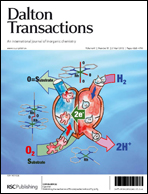The speciation in the mixed ThIV–FeIII system has been studied in aqueous solution in the pH range of 2.0–4.8. In the individual systems iron(III) and thorium(IV) hydrolyze easily and hydrolysis products precipitate at approximately pH ≥ 2.0 and 4.0, respectively, at the metal concentrations used in this study, 0.02–0.05 mol dm−3. In the mixed ThIV–FeIII system precipitation of ferrihydrite takes place after months of storage at low pH values, 2.0 (six-line ferrihydrite) and 2.3 (two-line ferrihydrite), as identified by X-ray powder diffraction. In the pH range 2.9–4.5 no precipitation was observed after 24 months. Two thorium(IV)–iron(III) solutions with pH = 2.9, CTh = 0.02 and 0.05 mol dm−3 and CFe = 0.02 mol dm−3, were studied by extended X-ray absorption fine structure, EXAFS, using the Fe K and Th L3 edges, and a third solution with pH = 2.9 and CTh = CFe = 0.40 mol dm−3 by large angle X-ray scattering, LAXS, to determine the structure of the predominating species. A heteronuclear hydrolysis complex with the composition [Th2Fe2(μ2-OH)8(H2O)12]6+ is proposed to form in solution, with Th⋯Th, Th⋯Fe and Fe⋯Fe distances of 3.94(2) and 3.96(2), 3.41(3) and 3.43(2), 3.04(2) and 3.02(4) Å, as determined by EXAFS and LAXS, respectively.


 Please wait while we load your content...
Please wait while we load your content...